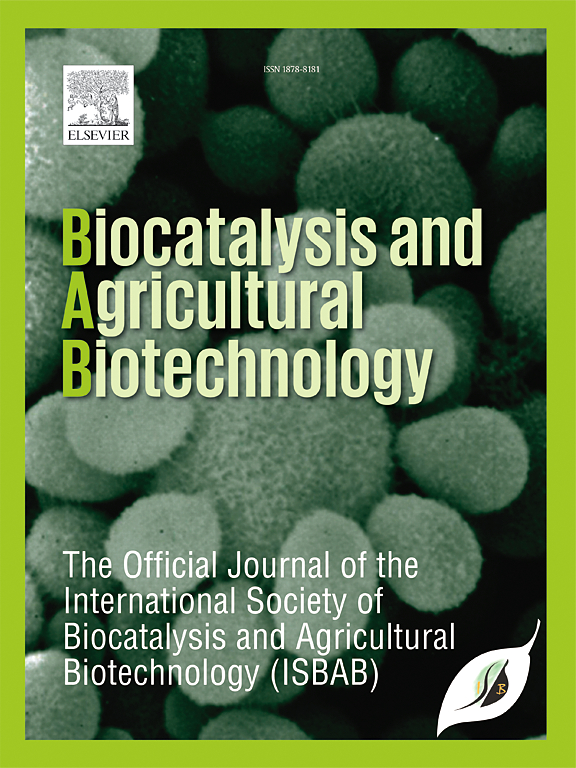Zeatin–auxin synergy and growing media optimization enhanced micropropagation, acclimatization, and antioxidant properties of ‘Bentong’ ginger (Zingiber officinale Roscoe)
IF 3.4
Q2 BIOTECHNOLOGY & APPLIED MICROBIOLOGY
引用次数: 0
Abstract
‘Bentong’ ginger (Zingiber officinale Roscoe) is a medicinally and economically important ginger cultivar in Malaysia. However, its conventional propagation via rhizomes is limited by low multiplication rates and a high risk of disease transmission. This study aimed to develop an efficient micropropagation protocol by optimizing the synergistic application of zeatin and auxins. Murashige and Skoog (MS) medium supplemented with 10 μM zeatin and 2.5 μM 1-naphthaleneacetic acid (NAA) significantly enhanced shoot multiplication (6.72 shoots per explant) and overall in vitro shoot development. Furthermore, the effects of different growing media on ex vitro acclimatization were evaluated. Plantlets grown in a 1:1:1 mixture of soil, coco peat, and vermiculite exhibited the highest survival rate (94.79 %) and superior vegetative and physiological performance, followed closely by a mixture of soil, peat moss, and vermiculite (93.75 % survival). Phytochemical analyses revealed no significant differences in total polyphenols content or antioxidant activities, assessed via 2,2-azino-bis (3-ethylbenzothiazoline-6-sulfonic acid) (ABTS) radical scavenging and iron-chelating assays, between rhizomes of micropropagated and conventionally propagated plants. These findings highlight the potential of zeatin–auxin synergy and optimized acclimatization media to efficiently produce disease-free, true-to-type ‘Bentong’ ginger planting materials.
玉米素-生长素协同作用和培养基优化提高了“本通”姜的微繁、驯化和抗氧化性能
“Bentong”姜(Zingiber officinale Roscoe)是马来西亚一种药用和经济上重要的生姜品种。然而,其传统的通过根茎繁殖受到繁殖率低和疾病传播风险高的限制。本研究旨在通过优化玉米素和生长素的协同应用,开发一种高效的微繁方案。在Murashige和Skoog (MS)培养基中添加10 μM玉米素和2.5 μM 1-萘乙酸(NAA)显著提高了试管苗的增殖率(每外植体6.72个芽)和试管苗的整体发育。此外,还评价了不同培养基对离体驯化的影响。在土壤、泥炭和蛭石1:1:1的混合物中生长的植株成活率最高(94.79%),营养和生理性能较好,其次是土壤、泥炭苔藓和蛭石的混合物,成活率为93.75%。植物化学分析显示,通过2,2-氮基-双(3-乙基苯并噻唑啉-6-磺酸)(ABTS)自由基清除和铁螯合测定,微繁殖和常规繁殖植物的根状茎在总多酚含量和抗氧化活性方面没有显著差异。这些发现突出了玉米素-生长素协同作用和优化的驯化培养基在高效生产无病、真正的“本通”生姜种植材料方面的潜力。
本文章由计算机程序翻译,如有差异,请以英文原文为准。
求助全文
约1分钟内获得全文
求助全文
来源期刊

Biocatalysis and agricultural biotechnology
Agricultural and Biological Sciences-Agronomy and Crop Science
CiteScore
7.70
自引率
2.50%
发文量
308
审稿时长
48 days
期刊介绍:
Biocatalysis and Agricultural Biotechnology is the official journal of the International Society of Biocatalysis and Agricultural Biotechnology (ISBAB). The journal publishes high quality articles especially in the science and technology of biocatalysis, bioprocesses, agricultural biotechnology, biomedical biotechnology, and, if appropriate, from other related areas of biotechnology. The journal will publish peer-reviewed basic and applied research papers, authoritative reviews, and feature articles. The scope of the journal encompasses the research, industrial, and commercial aspects of biotechnology, including the areas of: biocatalysis; bioprocesses; food and agriculture; genetic engineering; molecular biology; healthcare and pharmaceuticals; biofuels; genomics; nanotechnology; environment and biodiversity; and bioremediation.
 求助内容:
求助内容: 应助结果提醒方式:
应助结果提醒方式:


